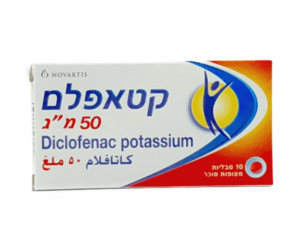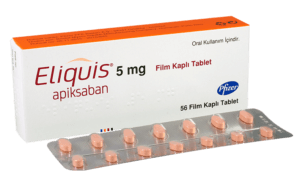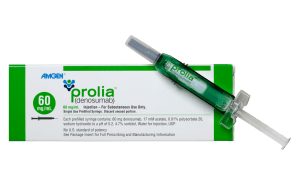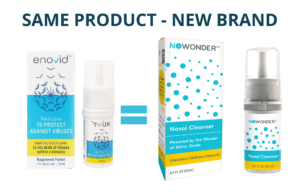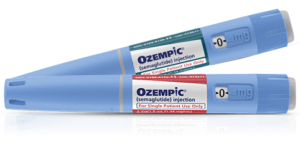 Most people are familiar with the broad group of pain-killer medications known as nonsteroidal anti-inflammatory drugs (NSAIDs). This is largely because many different brands of NSAIDs are sold over-the-counter and can be kept in the home medicine chest for relief of everyday aches and pains, including headaches, toothaches, mild-to-moderate bouts of arthritis, and other such transient attacks of pain and discomfort. However, it’s not fully understood why Cataflam is a special case amongst NSAIDs, and has some features that make it necessary only to be supplied by a pharmacy when prescribed by a healthcare provider. In this article, we’ll explore what sets Cataflam apart from other NSAIDs, why it may be prescribed, and what to expect from its effects.
Most people are familiar with the broad group of pain-killer medications known as nonsteroidal anti-inflammatory drugs (NSAIDs). This is largely because many different brands of NSAIDs are sold over-the-counter and can be kept in the home medicine chest for relief of everyday aches and pains, including headaches, toothaches, mild-to-moderate bouts of arthritis, and other such transient attacks of pain and discomfort. However, it’s not fully understood why Cataflam is a special case amongst NSAIDs, and has some features that make it necessary only to be supplied by a pharmacy when prescribed by a healthcare provider. In this article, we’ll explore what sets Cataflam apart from other NSAIDs, why it may be prescribed, and what to expect from its effects.
First, let’s get down to a general explanation of how NSAIDs generally work, what benefits they can bring, what to watch out for in case of adverse reactions, and how to manage their administration to achieve maximum benefits.
Introducing NSAIDs
Nonsteroidal anti-inflammatory drugs (NSAIDs) are a well-known class of medications usually selected for their ability to alleviate pain, reduce inflammation, and lower fever. Common examples include over-the-counter brands such as the original Bayer compound marketed for over 120 years as Aspirin, and newer forms of NSAIDs based on ibuprofen, such as Advil/Nurofen. Their versatility makes them a staple in managing various conditions, from headaches and menstrual cramps to arthritis and muscle injuries.
What is the mechanism of action of NSAIDs?
NSAIDs exert their effects by inhibiting the activity of COX-1 and COX-2 (cyclooxygenase) enzymes. These enzymes play a central role in the production of prostaglandins, which are compounds that are required to promote inflammation, pain, and fever. By blocking COX enzymes, NSAIDs decrease prostaglandin synthesis, leading to reduced inflammation and pain relief.
Take care, because COX-1 is also involved in maintaining the protective lining of the stomach. Therefore, inhibiting COX-1 can lead to gastrointestinal side effects, a consideration when using non-selective NSAIDs.
What are the benefits of NSAIDs?
The primary benefits of NSAIDs include:
- They are effective in alleviating mild to moderate pain, such as headaches, and the aftereffects of dental procedures and minor injuries.
- They can reduce inflammation associated with conditions like arthritis, tendinitis, and bursitis.
- They can lower the body’s temperature during fevers.
Their efficacy in these areas makes NSAIDs a common choice for both acute and chronic conditions.
What are the common side effects of NSAIDs?
While NSAIDs are generally safe when used appropriately, they can have negative side effects, especially with prolonged use or in higher doses:
- Indigestion and nausea are the most likely side effects. The risk grows when higher doses are taken or with prolonged use, possibly leading to more serious concerns like stomach ulcers or bleeding.
- Some NSAIDs may elevate the risk of heart attacks or strokes, particularly in individuals with pre-existing heart conditions.
- Prolonged use can affect kidney function, especially in people with existing kidney issues or when consumed in large doses.
- Allergic reactions can occur in susceptible individuals, ranging from mild skin rashes to severe reactions like anaphylaxis.
It’s essential to monitor for these side effects and consult with a healthcare provider if any adverse reactions occur.
How to get NSAIDs over-the-counter?

What makes Cataflam different from other NSAIDs?
Cataflam, with its active ingredient diclofenac, is also a nonsteroidal anti-inflammatory drug (NSAID) commonly prescribed for its potent anti-inflammatory and analgesic properties. While it shares similarities with other NSAIDs, several factors distinguish Cataflam from its counterparts.
Potency and efficacy
Studies have shown that diclofenac, the active component of Cataflam, is more potent than many over-the-counter NSAIDs like ibuprofen. Such studies have indicated that diclofenac at a daily dose of 150 mg may provide more effective pain relief than ibuprofen at 2400 mg per day.
This increased potency makes Cataflam particularly effective for conditions requiring strong anti-inflammatory action, such as arthritis.
Formulation and absorption 
Diclofenac is sold in two different formulations – potassium and sodium. The potassium salt is more soluble in water, leading to quicker dissolution and absorption in the gastrointestinal tract, whereas diclofenac sodium has a slower absorption rate. This difference means that diclofenac potassium formulations, like Cataflam, can provide faster pain relief compared to their sodium counterparts.
Cataflam is formulated as an immediate-release tablet, ensuring that the active ingredient is promptly available in the bloodstream after ingestion. Studies have shown that measurable plasma levels of diclofenac can be detected within 10 minutes of taking Cataflam, with peak concentrations typically reached in about 1 hour. This rapid pharmacokinetic profile underscores Cataflam’s suitability for acute pain scenarios where swift relief is desired.
Prescription status
Unlike NSAIDs such as ibuprofen and naproxen, which are available over the counter, Cataflam is typically available by prescription only. This is due to its potency and the need for medical supervision to monitor for potential side effects.
Side-effects
While Cataflam is effective in managing pain and inflammation, it is associated with a higher risk of gastrointestinal and cardiovascular side effects compared to some other NSAIDs. Therefore, its use should be carefully considered, especially in individuals with preexisting conditions related to the heart or digestive system.
Summary
Cataflam differs from other NSAIDs due mainly to its higher potency, rapid absorption, and prescription-only status, which make it a valuable option for managing moderate to severe pain and inflammation under medical supervision. However, due to its side effect profile, it is essential to use Cataflam as directed by a healthcare professional, who will consider the patient’s specific health conditions and the benefits measured against any potential risks.

